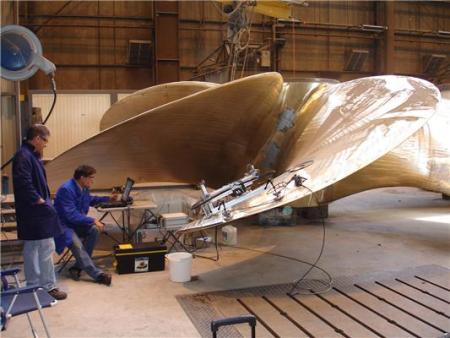Researchers from the Fraunhofer Institute for Industrial Mathematics (ITWM) have discovered a new type of ultrasound process to detect the material defects in ship propellers. Ship propeller manufacturing is a major challenge, as the propeller is as large as a single-family house.
 Suction feet are used to attach the mobile scanner to the propeller. Researchers record the ultrasound test data on-site. © Fraunhofer ITWM
Suction feet are used to attach the mobile scanner to the propeller. Researchers record the ultrasound test data on-site. © Fraunhofer ITWM
Propellers can weigh nearly 150 t and have a diameter of 9 m or higher. The damage of massive propellers can result in unpredictable consequences for the community and the environment. Several defects are produced during production or repair processes. For example, very small cracks and pores can be formed during the casting process and when the situation worsens, it may lead to break down of a blade.
Till date, propellers have been examined manually for internal defects, which is a time-consuming process. To overcome the drawback, Fraunhofer researchers have developed an automated mobile ultrasound test system, which can be utilized to test complex components in an easier and timely manner. The system can inspect copper-nickel-aluminum bronzes of about 450 mm thickness and identify very minute cracks. It has the ability to record a large amount of digitized ultrasound test data depending on the propeller surface. Currently, the ultrasound test system scans grids of 700 by 400 mm at a rate of about 100 mm/sec. The system can be fixed anywhere on the ship propeller and can be placed in a horizontal or vertical position via its suction feet.
The scientists use the mobile ultrasound test system to perform on-site testing in dry dock, on deck, at propeller manufacturer facilities and foundries. In addition to inspecting propellers, the process can be used to test other complex parts made of materials that are not easy to investigate, such as offshore components made from duplex steels.